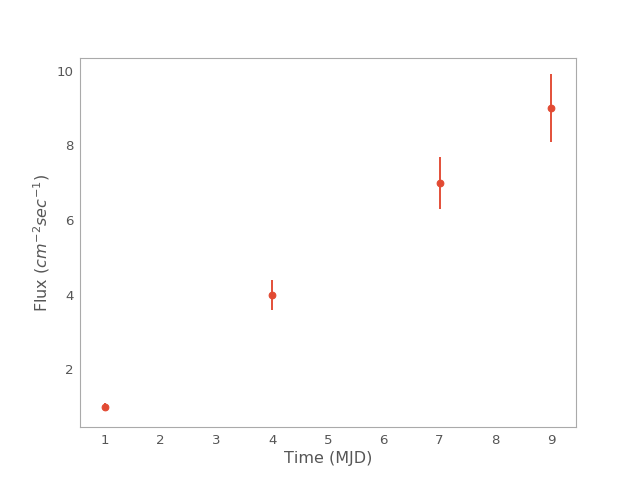Time handling and analysis (gammapy.time)¶
Introduction¶
gammapy.time contains methods for timing analysis.
TODO: explain gammapy.utils.time and why it’s separate.
At the moment there isn’t a lot of functionality yet ... contributions welcome!
Getting Started¶
Lightcurve¶
The LightCurve class can be used to read a lightcurve and plot it:
>>> from gammapy.time import LightCurve
>>> lc = LightCurve.simulate_example()
>>> lc.plot()
(Source code, png, hires.png, pdf)

Here’s how to compute some summary statistics for the lightcurve:
>>> lc['FLUX'].mean()
<Quantity 5.25 1 / (cm2 s)>
TODO: please help extend the functionality and examples for LightCurve!
Variability test¶
The exptest function can be used to compute the significance
of variability (compared to the null hypothesis of constant rate)
for a list of event time differences.
Here’s an example how to use the random_times helper
function to simulate a TimeDelta array for a given constant rate
and use exptest to assess the level of variability (0.11 sigma in this case,
not variable):
>>> from astropy.units import Quantity
>>> from gammapy.time import random_times, exptest
>>> rate = Quantity(10, 'Hz')
>>> time_delta = random_times(size=100, rate=rate, return_diff=True, random_state=0)
>>> mr = exptest(time_delta)
>>> print(mr)
0.11395763079
See examples/example_exptest.py for a longer example.
TODO: apply this to the 2FHL events and check which sources are variable as a nice example.
from gammapy.data import EventList
from gammapy.time import exptest
events = EventList.read('$GAMMAPY_EXTRA/datasets/fermi_2fhl/2fhl_events.fits.gz ', hdu='EVENTS')
# TODO: cone select events for 2FHL catalog sources, compute mr for each and print 10 most variable sources
Other codes¶
Where possible we shouldn’t duplicate timing analysis functionality that’s already available elsewhere. In some cases it’s enough to refer gamma-ray astronomers to other packages, sometimes a convenience wrapper for our data formats or units might make sense.
Some references (please add what you find useful
- https://github.com/astroML/gatspy
- https://github.com/matteobachetti/MaLTPyNT
- https://github.com/nanograv/PINT
- http://www.astroml.org/modules/classes.html#module-astroML.time_series
- http://www.astroml.org/book_figures/chapter10/index.html
- http://docs.astropy.org/en/latest/api/astropy.stats.bayesian_blocks.html
- https://github.com/samconnolly/DELightcurveSimulation
- https://github.com/cokelaer/spectrum
- https://github.com/YSOVAR/YSOVAR
- https://nbviewer.ipython.org/github/YSOVAR/Analysis/blob/master/TimeScalesinYSOVAR.ipynb
Reference/API¶
gammapy.time Package¶
Time-based analysis.
Functions¶
exptest(time_delta) |
Compute the level of variability for a certain period of time. |
plot_fermi_3fgl_light_curve(source_name[, ...]) |
Plot flux as a function of time for a fermi 3FGL object. |
random_times(size, rate[, dead_time, ...]) |
Make random times assuming a Poisson process. |
Classes¶
LightCurve([data, masked, names, dtype, ...]) |
LightCurve class. |
LightCurveEstimator(spec_extract) |
Class producing light curve. |